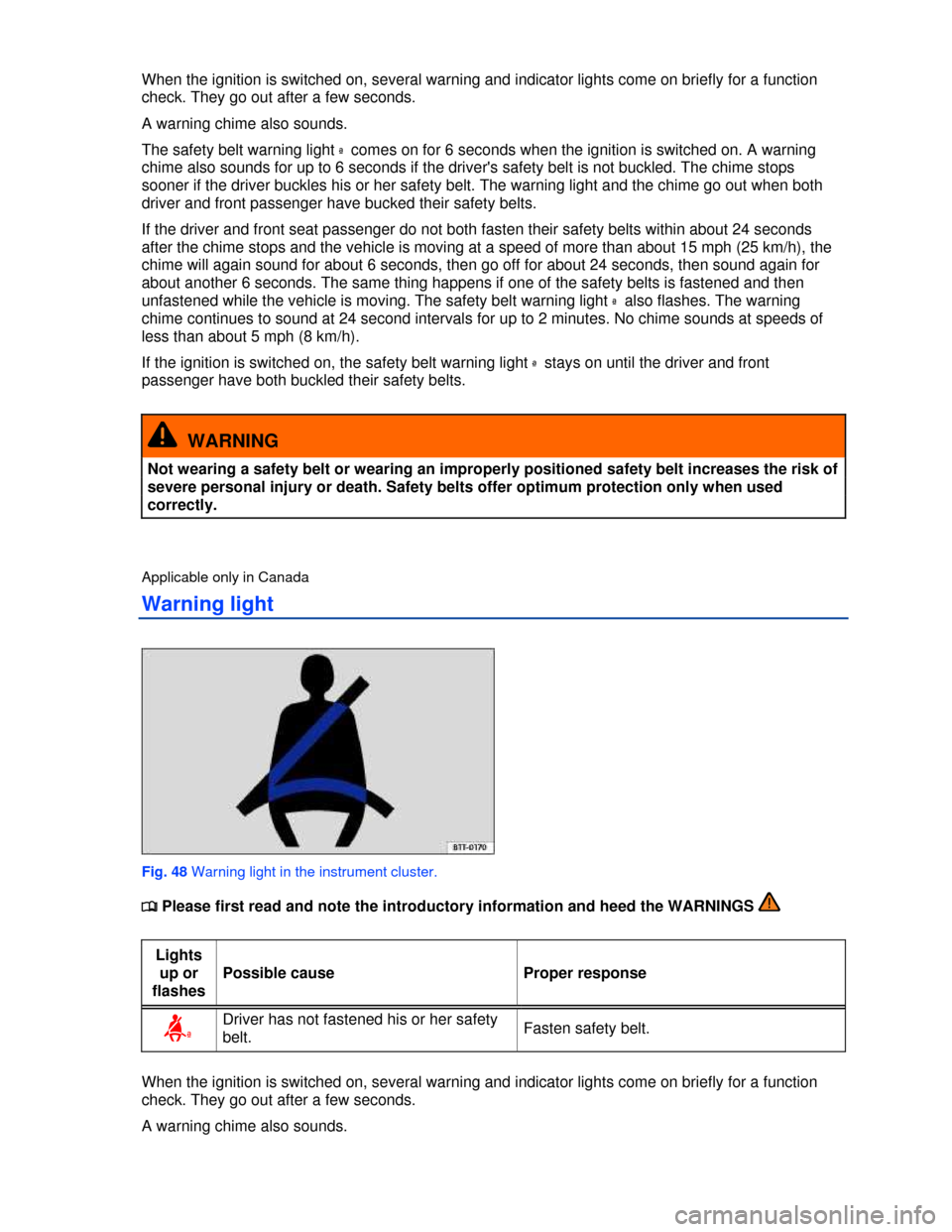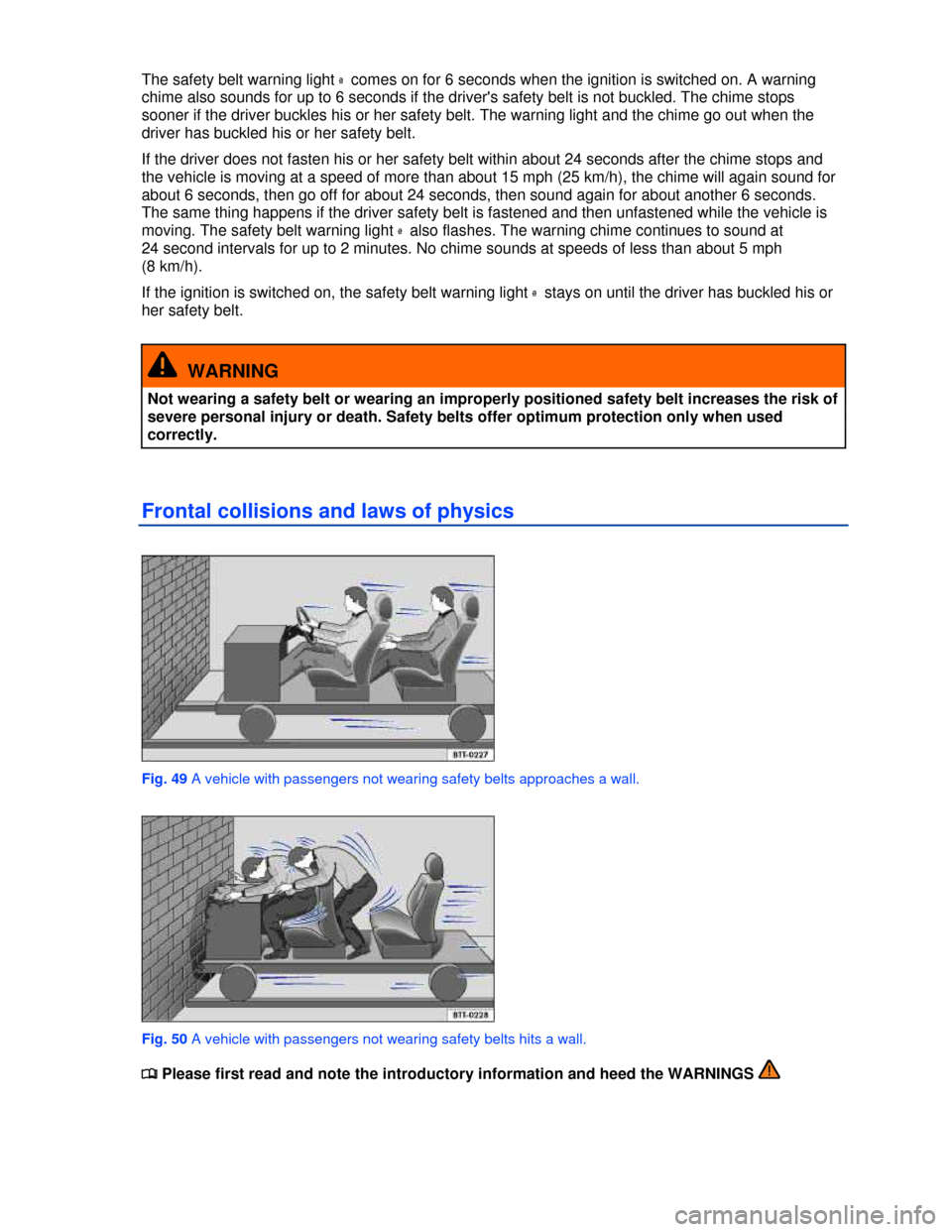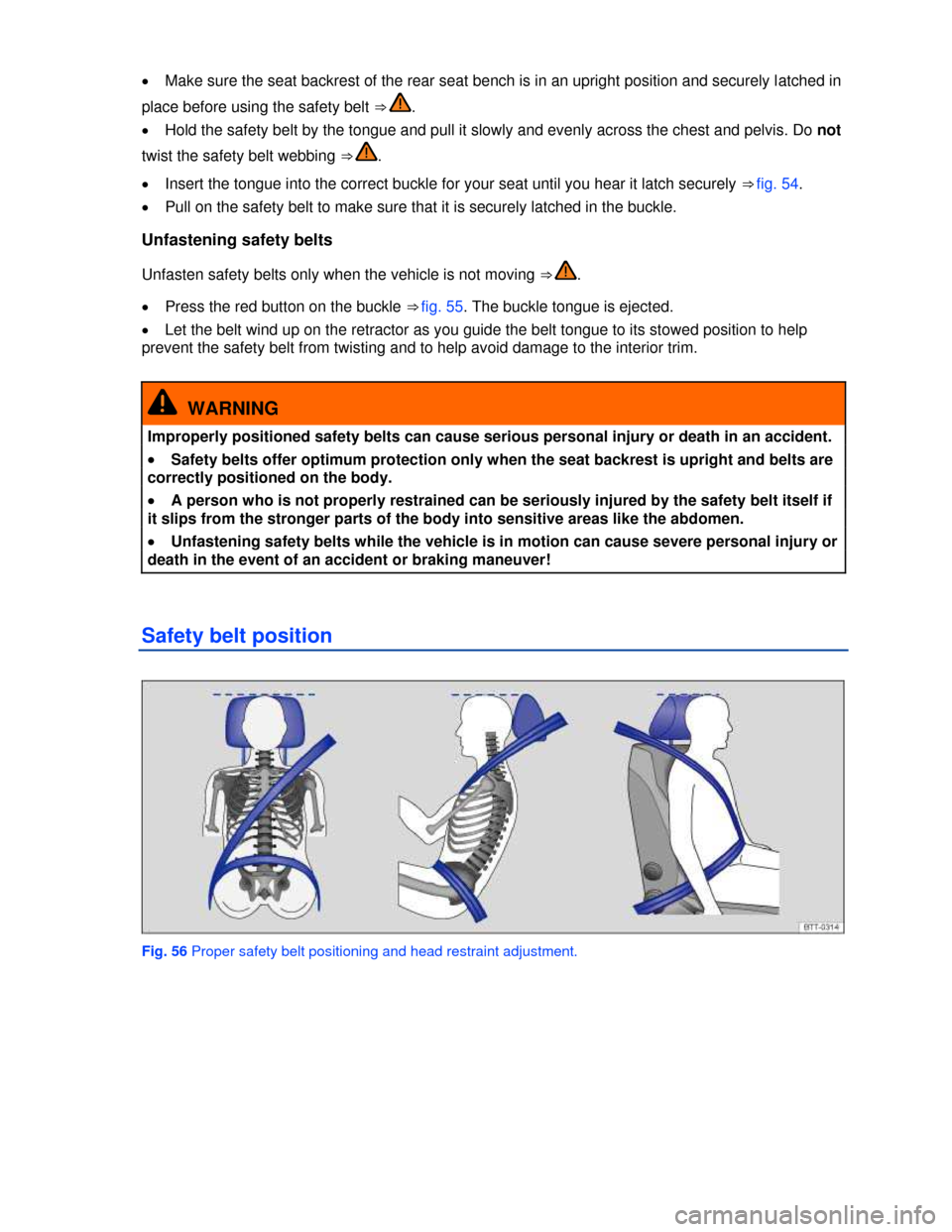Page 76 of 321

When the ignition is switched on, several warning and indicator lights come on briefly for a function
check. They go out after a few seconds.
A warning chime also sounds.
The safety belt warning light ª comes on for 6 seconds when the ignition is switched on. A warning
chime also sounds for up to 6 seconds if the driver's safety belt is not buckled. The chime stops
sooner if the driver buckles his or her safety belt. The warning light and the chime go out when both
driver and front passenger have bucked their safety belts.
If the driver and front seat passenger do not both fasten their safety belts within about 24 seconds
after the chime stops and the vehicle is moving at a speed of more than about 15 mph (25 km/h), the
chime will again sound for about 6 seconds, then go off for about 24 seconds, then sound again for
about another 6 seconds. The same thing happens if one of the safety belts is fastened and then
unfastened while the vehicle is moving. The safety belt warning light ª also flashes. The warning
chime continues to sound at 24 second intervals for up to 2 minutes. No chime sounds at speeds of
less than about 5 mph (8 km/h).
If the ignition is switched on, the safety belt warning light ª stays on until the driver and front
passenger have both buckled their safety belts.
WARNING
Not wearing a safety belt or wearing an improperly positioned safety belt increases the risk of
severe personal injury or death. Safety belts offer optimum protection only when used
correctly.
Applicable only in Canada
Warning light
Fig. 48 Warning light in the instrument cluster.
�
Page 77 of 321

The safety belt warning light ª comes on for 6 seconds when the ignition is switched on. A warning
chime also sounds for up to 6 seconds if the driver's safety belt is not buckled. The chime stops
sooner if the driver buckles his or her safety belt. The warning light and the chime go out when the
driver has buckled his or her safety belt.
If the driver does not fasten his or her safety belt within about 24 seconds after the chime stops and
the vehicle is moving at a speed of more than about 15 mph (25 km/h), the chime will again sound for
about 6 seconds, then go off for about 24 seconds, then sound again for about another 6 seconds.
The same thing happens if the driver safety belt is fastened and then unfastened while the vehicle is
moving. The safety belt warning light ª also flashes. The warning chime continues to sound at
24 second intervals for up to 2 minutes. No chime sounds at speeds of less than about 5 mph
(8 km/h).
If the ignition is switched on, the safety belt warning light ª stays on until the driver has buckled his or
her safety belt.
WARNING
Not wearing a safety belt or wearing an improperly positioned safety belt increases the risk of
severe personal injury or death. Safety belts offer optimum protection only when used
correctly.
Frontal collisions and laws of physics
Fig. 49 A vehicle with passengers not wearing safety belts approaches a wall.
Fig. 50 A vehicle with passengers not wearing safety belts hits a wall.
�
Page 78 of 321

The physical principles of a frontal collision are simple. Both the moving vehicle and the passenger
possess energy ⇒ fig. 49, which varies with vehicle speed and body weight. Engineers call this energy
“kinetic energy.”
The higher the speed of the vehicle and the greater the vehicle's weight, the more energy has to be
“absorbed” in a crash.
Vehicle speed is the most significant factor. If your speed doubles (for example, from 15 mph to
30 mph – 25 km/h to 50 km/h), the energy increases 4 times!
Because the occupants of the vehicle in the above example are not using safety belts, they are not
“attached” to the vehicle. In a frontal collision, they will keep moving at the same speed the vehicle
was moving just before the crash, until something stops them - here, the inside of the passenger
compartment. Because the occupants of the vehicle in the example are not wearing safety belts, their
entire kinetic energy will be absorbed by impact with the wall ⇒ fig. 50.
The same principles apply to people in a vehicle that is in a frontal collision on the highway. Even at
city speeds of 20–30 mph (30–50 km/h), the forces acting on the body can reach one ton (2,000 lbs or
1,000 kg) or more. At greater speeds, these forces are even higher.
Of course, the laws of physics don't apply just to frontal collisions; they determine what happens in all
kinds of accidents and collisions.
What happens to passengers not wearing a safety belt
Fig. 51 The unbelted driver is thrown forward.
Fig. 52 Unbelted passengers in the rear seats are thrown forward on top of the belted driver.
Page 80 of 321
Accident statistics show that vehicle occupants properly wearing safety belts have a lower risk of being
injured and a much better chance of surviving a collision. Properly using safety belts also greatly
increases the ability of the supplemental airbags to do their job in a collision. For this reason, wearing
a safety belt is required by law in most countries including the United States and Canada.
Although your Volkswagen is equipped with airbags, you still have to wear the safety belts provided.
Front airbags, for example, are activated only in some frontal collisions. The front airbags are not
activated in all frontal collisions, in side and rear collisions, in rollovers, or in cases when the
conditions for deployment stored in the electronic control unit are not met. The same goes for the other
airbag systems on your Volkswagen.
So always wear your safety belt and make sure that everybody in your vehicle is properly restrained!
Using safety belts
�
Page 81 of 321
WARNING
Improper use and care of safety belts increases the risk of severe personal injury or death.
�x Regularly check safety belts and related parts for damage.
�x Damaged safety belts must be replaced; they cannot be repaired.
�x Always keep safety belts clean.
�x Never catch, damage or chafe safety belt webbing on sharp edges.
�x Always keep objects and liquids away from the belt buckle and buckle opening.
Fastening and unfastening safety belts
Fig. 54 Inserting the safety belt buckle tongue into the belt buckle.
Fig. 55 Releasing the buckle tongue from the belt buckle.
�
Page 82 of 321

�x Make sure the seat backrest of the rear seat bench is in an upright position and securely latched in
place before using the safety belt ⇒ .
�x Hold the safety belt by the tongue and pull it slowly and evenly across the chest and pelvis. Do not
twist the safety belt webbing ⇒ .
�x Insert the tongue into the correct buckle for your seat until you hear it latch securely ⇒ fig. 54.
�x Pull on the safety belt to make sure that it is securely latched in the buckle.
Unfastening safety belts
Unfasten safety belts only when the vehicle is not moving ⇒ .
�x Press the red button on the buckle ⇒ fig. 55. The buckle tongue is ejected.
�x Let the belt wind up on the retractor as you guide the belt tongue to its stowed position to help
prevent the safety belt from twisting and to help avoid damage to the interior trim.
WARNING
Improperly positioned safety belts can cause serious personal injury or death in an accident.
�x Safety belts offer optimum protection only when the seat backrest is upright and belts are
correctly positioned on the body.
�x A person who is not properly restrained can be seriously injured by the safety belt itself if
it slips from the stronger parts of the body into sensitive areas like the abdomen.
�x Unfastening safety belts while the vehicle is in motion can cause severe personal injury or
death in the event of an accident or braking maneuver!
Safety belt position
Fig. 56 Proper safety belt positioning and head restraint adjustment.
Page 83 of 321
Fig. 57 Proper safety belt positioning for expectant mothers.
�
Page 84 of 321

WARNING
Improperly positioned safety belts can cause serious personal injury in an accident or a
sudden braking maneuver.
�x Always make sure that all vehicle occupants are correctly restrained and stay in a correct
seating position whenever the vehicle is being used.
�x Safety belts offer optimum protection only when the seat backrest is upright and belts are
correctly positioned on the body.
�x A loose-fitting safety belt can cause serious injuries by shifting its position on your body
from the strong bones to more vulnerable soft tissue and cause serious injury.
�x The shoulder belt portion of the safety belt must be positioned over the middle of the
occupant's shoulder and never across the neck or throat.
�x The safety belt must lie flat and snug on the occupant's upper body.
�x Never wear the shoulder part of the safety belt under your arm or otherwise out of
position.
�x The lap portion of the safety belt must be positioned as low as possible across the pelvis
and never over the abdomen. Make sure the belt lies flat and snug against the pelvis. Pull on
the safety belt to tighten if necessary.
�x Expectant mothers must always wear the lap portion of the safety belt as low as possible
across the pelvis and below the rounding of the abdomen.
�x Do not twist the belt when attaching it. If you cannot untwist a twisted safety belt, wear it
anyway, but make sure the twisted part is not in contact with your body. Have the problem
corrected right away by an authorized Volkswagen dealer or authorized Volkswagen Service
Facility.
�x Never hold the safety belt away from your body with your hand.
�x Never wear belts over rigid or breakable objects, such as eyeglasses, pens or keys.
�x Never modify the position of the belt using comfort clips, loops or similar devices.
If you have a physical impairment or condition that prevents you from sitting properly on the seat
with the safety belt properly fastened, special modifications to your vehicle may be necessary. Contact
your authorized Volkswagen dealer or authorized Volkswagen Service Facility or call the Volkswagen
Customer CARE Center at 1-800-822-8987 for information about possible modifications to your
vehicle.